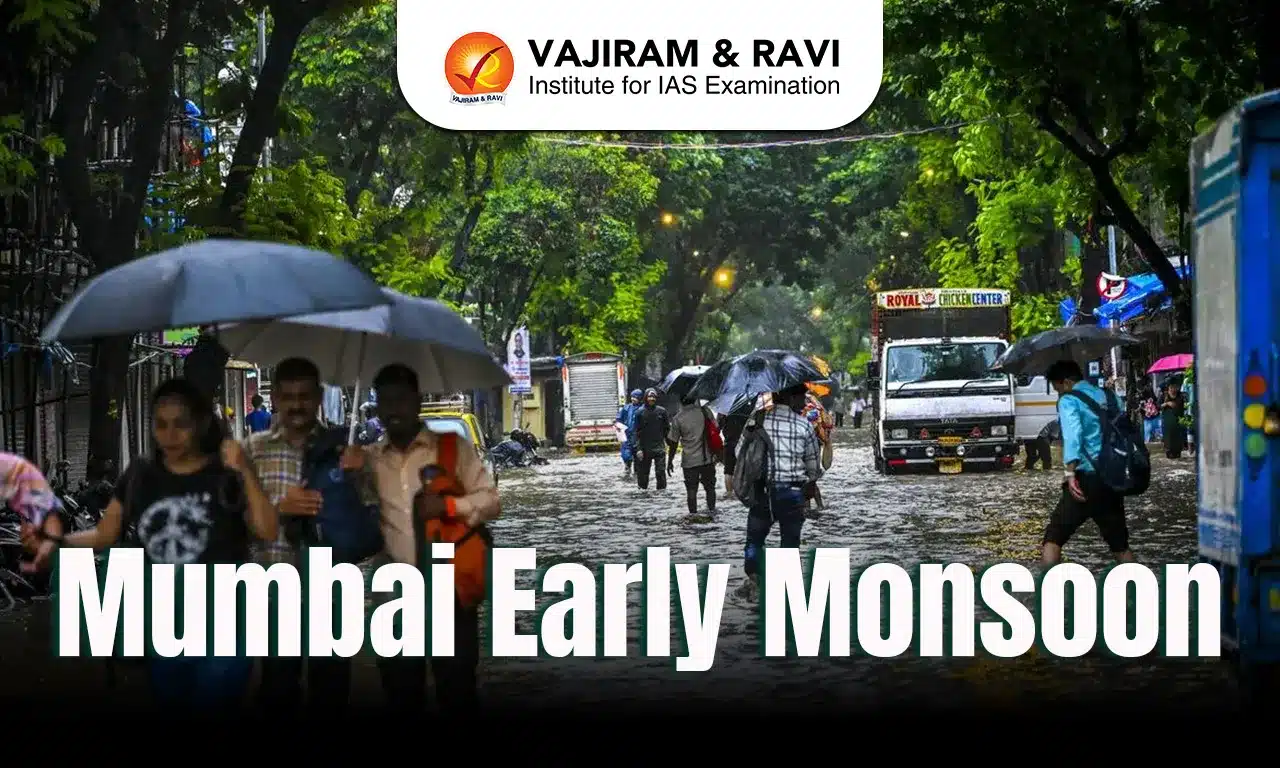Mumbai Early Monsoon Latest News
- Mumbai experienced an unusually early and intense monsoon, arriving two weeks ahead of schedule and disrupting daily life with waterlogging, traffic jams, and delayed trains.
- According to IMD records since 1950, this is the earliest monsoon onset ever recorded in the city, breaking the previous record of May 29. The normal onset date is June 11.
Madden-Julian Oscillation (MJO)
- MJO is an equatorial, eastward-moving system of anomalous rainfall and atmospheric circulation.
- It is planetary in scale and consists of alternating wet and dry phases, each lasting 30 to 60 days.
- It travels across the Indian and Pacific Oceans, sometimes reaching the Atlantic and re-entering the Indian Ocean.

Behavior and Mechanism
- The MJO features enhanced convection and suppressed rainfall zones that move eastward at about 5 m/s (11 mph).
- It affects surface winds, upper-level divergence, and ocean-atmosphere interactions.
- The active phase is monitored using outgoing longwave radiation—lower values indicate stronger convection (thunderstorms).
Phases of the MJO
- The MJO has two main phases:
- Enhanced Rainfall (Convective) Phase
- Surface Winds Converge: Air is drawn in at the surface and rises.
- Rising Air Cools and Condenses: This leads to cloud formation and increased rainfall.
- Upper-Level Wind Divergence: Winds reverse direction at the top of the atmosphere.
- Suppressed Rainfall Phase
- Upper-Level Winds Converge: Air descends from higher altitudes.
- Descending Air Warms and Dries: Leads to dry conditions and reduced rainfall.
- Surface Winds Diverge: Air spreads out at the surface, inhibiting convection.
Dipole Nature of MJO
- Strong MJO activity often divides the globe into two contrasting halves:
- One under enhanced convection and rainfall
- The other under suppressed convection and rainfall
- This dipole system moves eastward across the tropics, marking the progression of MJO.
Criteria for Active MJO
- To be classified as active, the dipole must be:
- Clearly defined
- Propagating eastward over time
Impact on Indian Monsoon
- The MJO significantly influences the timing, intensity, and breaks in the Indian monsoon.
- Stronger rainfall often occurs in India 5–10 days after warming of sea surface temperatures linked to the MJO.
- The break in monsoon, especially in July, is often caused when the MJO’s active phase moves eastward away from the region.
Impact on Tropical Cyclones
- MJO plays a role in tropical cyclogenesis by creating favorable or unfavorable large-scale conditions.
- Ascending motion enhances storm formation.
- Descending motion suppresses cyclone activity.
- The preferred cyclone region shifts from Western Pacific → Central Pacific → Atlantic as the MJO progresses.
- There’s an inverse cyclone activity pattern between the North Pacific and North Atlantic, influenced by opposite MJO phases.
Factors Behind Mumbai’s Earliest Monsoon Onset
- Early Onset in Kerala
- The monsoon arrived in Kerala on May 24 — the earliest since 2009 — setting the stage for its rapid advancement.
- Typically, Mumbai receives monsoon around June 11, nearly 10 days after Kerala.
- Rapid Progression
- Unusually, the southwest monsoon travelled from Kerala to Maharashtra within just 24 hours, reaching Mumbai by May 27.
- Favourable Weather Conditions
- According to IMD, very favourable atmospheric conditions supported both the early onset and fast progression of the monsoon.
- Active Madden-Julian Oscillation (MJO):
- A highly active MJO — a global system of wind and pressure patterns — was in Phase 4 with high amplitude, creating ideal conditions for enhanced rainfall and storm activity over India.
- MJO phase 4 represents a period of enhanced rainfall over the Indian Ocean and western Pacific, with a slight increase in rainfall over the southwest quarter of the globe, while other regions experience slightly below normal rainfall.
- A highly active MJO — a global system of wind and pressure patterns — was in Phase 4 with high amplitude, creating ideal conditions for enhanced rainfall and storm activity over India.
- Strong Cross-Equatorial Flow
- This flow, which transports moisture across the equator, was particularly strong, bringing in significant humidity needed to fuel monsoon clouds.
- Low Pressure in Arabian Sea
- A low-pressure area, formed due to cyclonic circulation, not only contributed to heavy pre-monsoon showers in Mumbai but also accelerated the monsoon’s arrival.
Mumbai Early Monsoon FAQs
Q1. Which month is heavy rain in Mumbai?
Ans. July to September are the months when the monsoon sets in, and Mumbai experiences torrential rains. The weather becomes humid, but the rains bring relief from the scorching heat.
Q2. What caused Mumbai’s early monsoon?
Ans. A strong MJO, active low-pressure area, and rapid cross-equatorial moisture flow.
Q3. What is MJO Phase 4?
Ans. It brings enhanced rainfall over the Indian Ocean, supporting strong monsoon activity.
Q4. How fast did the monsoon move from Kerala to Mumbai?
Ans. It took only 24 hours—an unusually rapid progression.
Q5. Did unusual May weather affect Mumbai?
Ans. Yes, it led to intense rainfall, waterlogging, and transportation disruptions before June.
Last updated on June, 2025
→ UPSC Notification 2025 was released on 22nd January 2025.
→ UPSC Prelims Result 2025 is out now for the CSE held on 25 May 2025.
→ UPSC Prelims Question Paper 2025 and Unofficial Prelims Answer Key 2025 are available now.
→ UPSC Calendar 2026 is released on 15th May, 2025.
→ The UPSC Vacancy 2025 were released 1129, out of which 979 were for UPSC CSE and remaining 150 are for UPSC IFoS.
→ UPSC Mains 2025 will be conducted on 22nd August 2025.
→ UPSC Prelims 2026 will be conducted on 24th May, 2026 & UPSC Mains 2026 will be conducted on 21st August 2026.
→ The UPSC Selection Process is of 3 stages-Prelims, Mains and Interview.
→ UPSC Result 2024 is released with latest UPSC Marksheet 2024. Check Now!
→ UPSC Toppers List 2024 is released now. Shakti Dubey is UPSC AIR 1 2024 Topper.
→ Also check Best IAS Coaching in Delhi
Tags: mains articles mumbai early monsoon upsc current affairs upsc mains current affairs





















